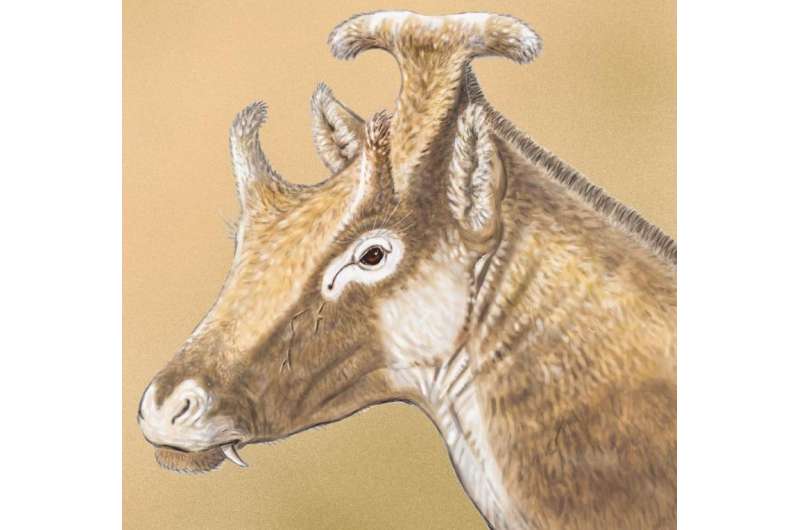A reconstruction of X. amidalae. Credit: Israel M. Sánchez
The extinct three-horned palaeomerycid ruminant, Xenokeryx amidalae, found in Spain, may be from the same clade as giraffes, according to a study published December 2, 2015 in the open-access journal PLOS ONE by Israel M. Sánchez from the Museo Nacional de Ciencias Naturales-CSIC, Madrid, Spain, and colleagues.
Palaeomerycids, now extinct, were strange three-horned Eurasian Miocene ruminants known through fossils from Spain to China. In this article, the authors classify the palaeomerycid to their clade based on shared characteristics with the best-known species of the group and reassess their phylogenetic position among ruminants, which is currently disputed. The authors use well-preserved remains of a new palaeomerycid, Xenokeryx amidalae, which included a complete sample of cranial—including both frontal and supra-occipital 't-shaped' cranial appendages—dental, and postcranial remains, from middle Miocene deposits of Spain.
The authors found that despite their apparent external similarities, Eurasian palaeomerycids are not closely related to North American dromomerycids, distant relatives to deer, as some scientists have thought. Instead, palaeomerycids are in the clade Giraffomorpha, the least inclusive clade containing Giraffa and Triceromeryx. The authors conclude that future ruminant research will benefit from more in-depth analysis, such as phylogenetic analysis combining fossil and living taxa, morphological and molecular datasets, and fossil ages.
Israel Sánchez adds: "Establishing the place of palaeomerycids in the ruminant tree gives us insights into the evolutionary history of the large clade of pecoran ruminants that include giraffes (Giraffa and Okapia) as its only extant survivors, and shows us the amazing diversity of an ancient lineage that inhabited both Eurasia and Africa."
More information: PLOS ONE, dx.plos.org/10.1371/journal.pone.0143034
Journal information: PLoS ONE
Provided by Public Library of Science























